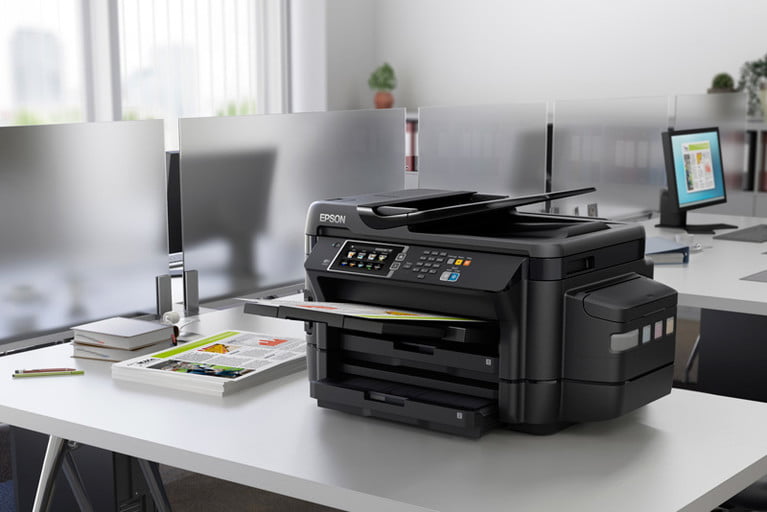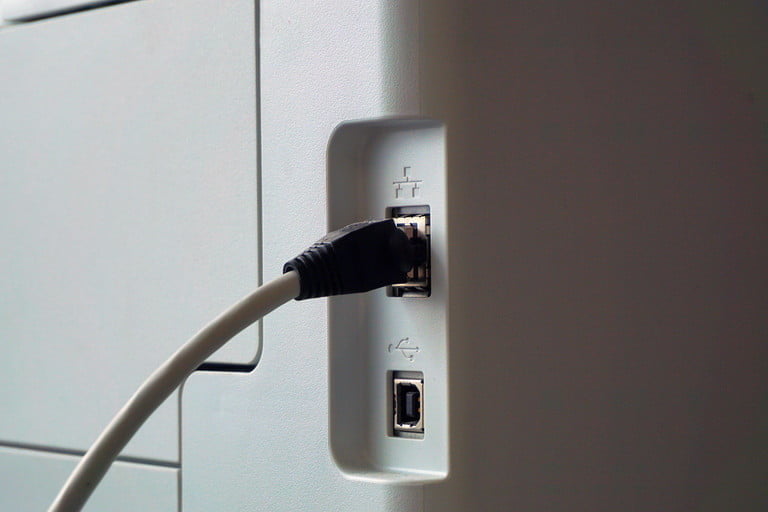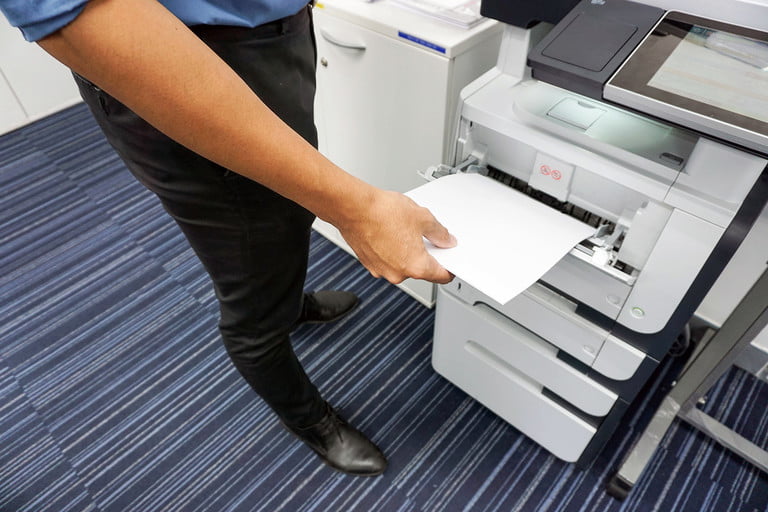
Whatever you need to print, there’s a home printer that can do it. But knowing how to choose a printer isn’t always easy, given the sheer number of options on the market. To help, we’ve put together a quick buying guide for selecting a home printer, with simple explanations of some of the most common terms, plus recommendations that will serve the majority of buyers.
Color inkjet printers comprise the bulk of the market simply because they can print just about anything: Essays, pie charts, glossy photos, you name it. And today’s inkjet printers and all-in-ones are fast, often with print speeds that rival or surpass their laser counterparts.
Laser printers are still a good bet for office settings when most of the printing that you need to do is in monochrome. For the most part, monochrome laser printers can be purchased at affordable prices, offer good print speed, and provide prints at a lower cost per page than a color inkjet. But you have to decide whether to give up the flexibility that a color inkjet printer offers. Color laser printers are another option, but they generally have a higher cost per page printed than a color inkjet.
Laser printers tend to have excellent page yields; their long-lasting toner cartridges can last between 3,000 and 20,000 pages before they need to be replaced. Inkjet cartridges tend to last for up to 2,000 to 2,500 on average. That’s less important if you don’t print much or often, but for prolific printers or those buying for an office, it can make a real difference.
Multifunction printers
A multifunction printer is a printer that can also scan and fax as well as print. They come in both inkjet and laser varieties and are usually called “all-in-ones” or multifunction printers (MFPs).
For home use, a multifunction unit makes a lot of sense, not only because it’s cheaper than buying a printer and a standalone scanner, but also for the sake of saving room. Since all-in-ones are extremely common and manufacturers rarely charge much of a premium for them (you can often find some for as little as $50 to $60), we highly recommend them for home users.
MFPs make it easy to scan documents directly to your computer, while some even offer faxing. They’re more likely to be used in the office, but even then, faxing has largely faded out of the business world except in a few select industries, so the added value isn’t great.
Photo printers

If you’re more interested in preserving family photos on paper than printing off homework assignments and pie charts, consider a dedicated (single function) photo printer. Though they lack the flexibility of multitaskers and the quality of prints is typically better, often rivaling or exceeding the quality of what you would receive from a kiosk or mail-order service. The price you’ll pay for this kind of convenience comes out in the print cost, however.
Many of the printers sold only for dedicated photo or graphic use are small-size units capable of printing photos up to 4 by 6 inches in size or wide format models designed to print media up to 24 inches wide. Supplies for these specialty printers are also generally more expensive than those for the typical multifunction printer. Both Canon and Epson have models that print 8.5 by 11 inches and use five or six colors of ink to produce photos with greater color accuracy. And many all-in-one devices are capable of turning out photos up to 8.5 by 11 inches in size when you use the right paper.
Speed, resolution, and color claims
It used to be fairly easy for a printer manufacturer to make outrageous claims about how fast their printers were or what you could expect as far as page yield from an ink or toner cartridge. Today, nearly all vendors use a standardized set of tests developed and licensed by the International Organization for Standardization (ISO). The ISO test protocols provide a level playing field — all the claims and ratings are developed using the same document sets and the test procedures. Important specs include:
PPM: This means “pages per minute” and is a guide to how fast a printer can print pages. That seems simple enough, but PPM can quickly grow complex. For example, printers have very different PPMs for black and white versus color, so it’s common for many printers to provide two different PPMs if they are color-focused. PPM isn’t especially important for home printers unless you find yourself under time pressure for a print job or need to print a lot at once. Average black-and-white PPM is around 15 to 20 pages. Color tends to be less, at around 10 to 15 pages per minute.
DPI: This refers to “dots per inch” or how many dots of ink the printer can apply to a square inch of paper. This spec is useful in studying just how good a printer is at creating high-resolution, high-detail images. It’s also a little outdated, however: Newer printing methods and software can enhance the resolution of a printed image without changing the DPI, so don’t let it be the ultimate deciding spec.
Duty cycle: This number is how many pages per month a printer can reasonably be expected to print. You want your expected number of pages per month to be well below this number so your printer doesn’t experience as much wear and tear. It’s an important number for a busy office with lots of printing needs, but it’s less important for the typically less-intense home use.
Use these specs as a basis for comparing one device with another, but remember that they aren’t all-encompassing factors, especially if you’re looking for something specific.
Connectivity

It used to be fairly easy for a printer manufacturer to make outrageous claims about how fast their printers were or what you could expect as far as page yield from an ink or toner cartridge. Today, nearly all vendors use a standardized set of tests developed and licensed by the International Organization for Standardization (ISO). The ISO test protocols provide a level playing field — all the claims and ratings are developed using the same document sets and the test procedures. Important specs include:
PPM: This means “pages per minute” and is a guide to how fast a printer can print pages. That seems simple enough, but PPM can quickly grow complex. For example, printers have very different PPMs for black and white versus color, so it’s common for many printers to provide two different PPMs if they are color-focused. PPM isn’t especially important for home printers unless you find yourself under time pressure for a print job or need to print a lot at once. Average black-and-white PPM is around 15 to 20 pages. Color tends to be less, at around 10 to 15 pages per minute.
DPI: This refers to “dots per inch” or how many dots of ink the printer can apply to a square inch of paper. This spec is useful in studying just how good a printer is at creating high-resolution, high-detail images. It’s also a little outdated, however: Newer printing methods and software can enhance the resolution of a printed image without changing the DPI, so don’t let it be the ultimate deciding spec.
Duty cycle: This number is how many pages per month a printer can reasonably be expected to print. You want your expected number of pages per month to be well below this number so your printer doesn’t experience as much wear and tear. It’s an important number for a busy office with lots of printing needs, but it’s less important for the typically less-intense home use.
Use these specs as a basis for comparing one device with another, but remember that they aren’t all-encompassing factors, especially if you’re looking for something specific.
Connectivity
USB: USB connections are common on printers, with the USB-A standard being especially common. This allows you to hook up external hard drives and a variety of other devices, then use the printer’s menu screen to print files directly off of them. It’s useful if you don’t want to use your computer as a go-between. Cameras and other devices supporting the PictBridge standard can make this process even smoother, but it’s not as necessary as it was when introduced in 2003. Keep in mind that most home printers don’t support USB-C connections yet, although that’s changing.
Ethernet: Printers may also be equipped with Ethernet ports for wired connections to the internet. Printer data needs are fairly basic, however, and a wired Ethernet connection is rarely necessary for a home printer (it can be more useful in some office printer setups).
Wi-Fi: The majority of home printers are designed to connect directly to your Wi-Fi network. You will typically provide them with your Wi-Fi information during setup. Then you can download software on your computer, phone, or another device to send printing jobs directly to the printer, no cable necessary. It’s one of the most convenient options for home projects. Wi-Fi connections also allow for remote printing to an office, which can be very important in work-from-home situations.
Wi-Fi Direct: Wi-Fi Direct is a peer-to-peer connection not really related to your Wi-Fi network. Instead, it establishes a secure signal directly between a device and the printer. Apple’s AirPrint, for example, is a type of Wi-Fi Direct connection, and other platforms support similar technologies. It’s safe, quick, and great for on-the-spot printing needs.
NFC: NFC (Near-Field Communication) is also available on some models, letting you connect your printer to a smartphone or tablet by simply touching the device to a specified area on your printer.
Cloud printing: Many fully featured printers, particularly AIOs, now offer internet-based features that let you access photos stored on sites such as Facebook, Flickr, Dropbox, and Google Drive, as well as remote printing and access to arts and crafts you can print out. Keep in mind that if your printer isn’t connected to the internet, you won’t be able to access said services or print to it remotely from devices such as a smartphone or tablet.
SD cards: Some printers may also have slots for SD cards, which you can then navigate through using the printer’s menu and choose select files to print. This may be especially useful for photographers who can transfer SD cards directly from cameras to printers.
Ink costs

If you regularly perform big print jobs — perhaps for a home-based business or a remote work situation that requires hard copies — then printing ink cost is a big factor to consider.
Ink cost can be measured per page, but efficiency depends on the printer model and how it’s designed. A powerful, expensive printer may only cost around 4 cents per black-and-white page and 8 cents per colored page. A more affordable printer (or cheaper cartridge) may increase these costs by a couple of cents, but it’s not an enormous difference unless you’re printing hundreds and hundreds of pages every month. Some printers will provide direct cost-per-print information you can look up to learn more, or you can divide the cost of toner cartridges versus the cartridge page yield from the cost per print yourself.
Subscription plans for a continued supply of printer ink can help cut costs for home businesses if necessary. Buying refilled cartridges or refilling them yourself is a tricky prospect: Many printers won’t recognize cartridges that aren’t new and purchased directly from the manufacturer.
Duplexing (two-sided printing or scanning)
One feature that’s becoming very common and that we consider a big plus is automatic duplexing. Duplexing refers to printing or scanning both sides of the page without requiring that you manually flip the page over. On a printer, duplexing is accomplished by printing the first side of the page, pulling the page back through the printer, flipping it over, and printing the other side.
Many all-in-one devices with an automatic document feeder (ADF) for the scanner also have duplexing, allowing you to scan both sides of the page as the document feeds through the ADF. An all-in-one without an automatic document feeder can’t duplex scan without you turning the page over on the scan glass.
Duplex scanning is a major convenience if you frequently scan two-sided pages, like those cut from a magazine.
Paper handling

Every printer will feed on a fat stack of 8.5 by 11 paper, but what about legal envelopes, index cards, and glossy stock? Thankfully, many printers now include dedicated feed trays for printing on specialty papers with unusual sizes or different weights, which make it easier to deal with those situations when they crop up. Consider the size of the input tray here: Smaller trays will require you to add paper all the time, while a 250-page hopper can make it a once-a-month affair.
Printers for the modern paperless home

Many printer buyers in the 2020s face a conundrum of a different sort: Their homes are largely paperless, and most of their work is digital. Yet, they still need a printer for the occasional photo art project or scanning and sending in a signature. To buyers like these, a big printer may not be worth it, especially when it comes to the space they take up and their ink cartridge maintenance.
A new type of printer has risen in popularity in response — compact, often-portable home printers that are made for the odd job here and there without taking up any space or effort. One example is the Canon Pixma iP110 wireless printer. Another choice is the highly portable HP Tango X. Printers like these are designed to work right from your phone or laptop and can fit nearly anywhere.
In the meantime, check out our guide to find the best 3D printer for your needs.

